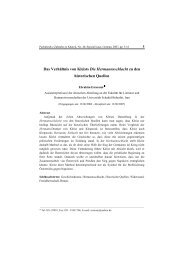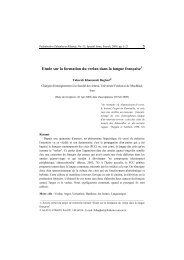Phonological Metathesis in Persian: Synchronic, Diachronic, and the ...
Phonological Metathesis in Persian: Synchronic, Diachronic, and the ...
Phonological Metathesis in Persian: Synchronic, Diachronic, and the ...
Create successful ePaper yourself
Turn your PDF publications into a flip-book with our unique Google optimized e-Paper software.
10 Pazhuhesh-e Zabanha-ye Khareji, No. 56, Spr<strong>in</strong>g 2010<br />
Support for this claim comes from this fact that before a morpheme beg<strong>in</strong>n<strong>in</strong>g<br />
with a simple onset, as <strong>in</strong> <strong>the</strong> follow<strong>in</strong>gs, a consonant f<strong>in</strong>al morpheme does not<br />
undergoes meta<strong>the</strong>sis:<br />
Leti<br />
/urun/<br />
urun moa<br />
/lout/<br />
lout de<br />
Ano<strong>the</strong>r function of meta<strong>the</strong>sis <strong>in</strong> Leti is <strong>the</strong> avoidance of onsetless syllables. In<br />
/ukar +muani/ > ukramwan meta<strong>the</strong>sis occurs before a morpheme <strong>in</strong>itial /CVV/<br />
sequence, where <strong>the</strong> f<strong>in</strong>al vowel <strong>and</strong> consonant of <strong>the</strong> <strong>in</strong>itial morpheme reverse<br />
positions. In this case meta<strong>the</strong>sis is motivated by <strong>the</strong> need to avoid vowel hiatus: that<br />
is, an onsetless syllable:<br />
In this section it was argued that meta<strong>the</strong>sis arises to have a better syllable<br />
structure to produce <strong>and</strong> perceive speech sounds. Also for account<strong>in</strong>g meta<strong>the</strong>sis <strong>the</strong><br />
nature of sound <strong>and</strong> <strong>the</strong> context of occurrence are important.<br />
3. Types of meta<strong>the</strong>sis<br />
<strong>Meta<strong>the</strong>sis</strong> is categorized <strong>in</strong>to four types: perceptual meta<strong>the</strong>sis, compensatory<br />
meta<strong>the</strong>sis, articulatory meta<strong>the</strong>sis, auditory meta<strong>the</strong>sis.<br />
3.1. Perceptual meta<strong>the</strong>sis<br />
Perceptual meta<strong>the</strong>sis <strong>in</strong> which certa<strong>in</strong> features <strong>in</strong> effect jump over adjacent<br />
segments is closely l<strong>in</strong>ked to <strong>the</strong> segmentation problem. Perceptual meta<strong>the</strong>sis<br />
orig<strong>in</strong>ates when features, extend<strong>in</strong>g across a CV or VC doma<strong>in</strong> or perceived as<br />
extend<strong>in</strong>g across such a doma<strong>in</strong>, are perceived as orig<strong>in</strong>at<strong>in</strong>g <strong>in</strong> a position which is<br />
not <strong>the</strong> surface postion. As emphasized by Ohala (1993) <strong>in</strong> his discussion of<br />
dissimilation, certa<strong>in</strong> perceptual features are typically realized over relatively short<br />
time duration, whereas o<strong>the</strong>rs are typically realized over relatively long duration.<br />
For example, irrespective of its phonological association with a consonant, vowel or<br />
glide, pharyngealization is typically phonetically realized over a m<strong>in</strong>imal CV or VC<br />
doma<strong>in</strong>. In case of perceptual meta<strong>the</strong>sis, a segment (or feature) with elongated






